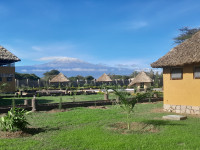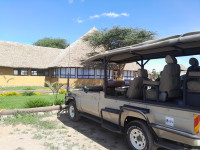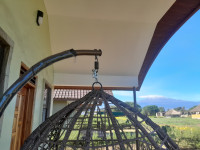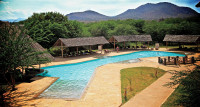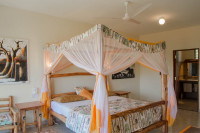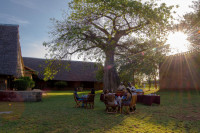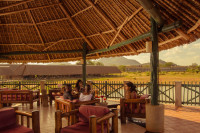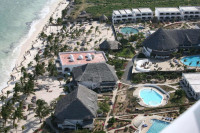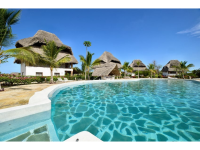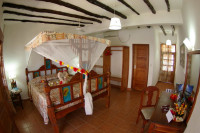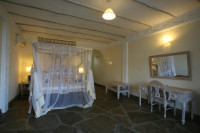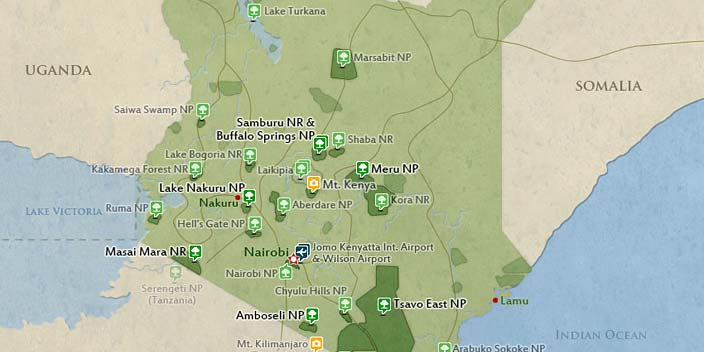
$1,988 to $2,207 pp (USD)
2 travelers on Start dateArrival
Arrival

Day 1
Nairobi – Amboseli National Park
Nairobi – Amboseli National Park
Depart Nairobi and head to Amboseli Park a 4-5 hours drive. Arrive, check in and have lunch at your lodge. Amboseli is a rich bird life destination, with over 400 bird species recorded, including the globally threatened Madagascar Pond-Heron, Lesser Flamingo, Lesser Kestrel and possibly Africa’s most sought –after bird, the Shoebill which has an a –one-time record in the area and over 40 birds of prey. The park's diverse ecosystem makes it a hotspot for bird photographers as well. The park also has forty-two of the ninety-four species of the Somali-Maasai biome that occur in Kenya. To find Amboseli a very productive bid watching spot, one needs to get there during and just after the October-December rains. This is when local birds are joined by migrants from the Northern hemisphere, sometimes in fairly large numbers. Migratory birds can be seen through November to April, the best time when a good species are recorded is during the months of November, December, January, April and May.
- Main Destination:
- Amboseli National Park
- Accommodation:
- Penety Amboseli Resort
- Meals & Drinks:

Day 2
Amboseli National Park
Amboseli National Park
Wake up early to catch the birds at their most active. Focus on the park’s wetlands & swamps, where you can spot water birds like egrets, herons, pelicans, crowned cranes. Capture the stunning landscapes and birdlife with Mount Kilimanjaro as the backdrop. Stop at Observation Hill for panoramic views of the park & Mount Kilimanjaro, This is also a great spot to see raptors and other birds of prey. In the mid-morning, continue to the swamp areas; the Ol Okenya Swamp where you can see variety of bird species including the African jacana, Goliath heron and grey crowned crane. Take a short break at a designated picnic area to enjoy some tea, observing the birds. Explore the park’s grasslands, acacia woodlands, looking out for ground birds like Hartlaub’s bustard, localized Pangani longclaw. Head for lunch, return for a second game drive focusing on different habitats to maximize birdwatching opportunities. Stop at boreholes where birds come to drink & bathe to see a variety of species.
- Main Destination:
- Amboseli National Park
- Accommodation:
- Penety Amboseli Resort
- Meals & Drinks:

Day 3
Amboseli National Park
Amboseli National Park
Wake up early to catch the birds at their most active. Focus on the park’s wetlands & swamps, where you can spot water birds like egrets, herons, pelicans, crowned cranes. Capture the stunning landscapes and birdlife with Mount Kilimanjaro as the backdrop. Stop at Observation Hill for panoramic views of the park & Mount Kilimanjaro, This is also a great spot to see raptors and other birds of prey. In the mid-morning, continue to the swamp areas; the Ol Okenya Swamp where you can see variety of bird species including the African jacana, Goliath heron and grey crowned crane. Take a short break at a designated picnic area to enjoy some tea, observing the birds. Explore the park’s grasslands, acacia woodlands, looking out for ground birds like Hartlaub’s bustard, localized Pangani longclaw. Head for lunch, return for a second game drive focusing on different habitats to maximize birdwatching opportunities. Stop at boreholes where birds come to drink & bathe to see a variety of species.
- Main Destination:
- Amboseli National Park
- Accommodation:
- Penety Amboseli Resort
- Meals & Drinks:

Day 4
Amboseli National Park - Tsavo West National Park
Amboseli National Park - Tsavo West National Park
Depart for Tsavo West National Park, one of the best parks to go birding. It is 9065 km square & contain extensive land of grey thorn bush, red ochre sand, which are covered with tall lush green grasses if you are lucky to be there after good rains. The best time to visit the park is from October-April when the bird migration is on. In this park, you are likely to see species like the Golden-breasted, Fischer’s Starling, Grasshopper Buzzard, Friedman’s and Singing Bush Lark, Somali Bee-eater, Pringle’s Puff back, Tsavo Sunbird, Taveta –golden Weaver, Common White-throat, Brown-breasted Barbet. Thousands of Palearctic migrants move through the Tsavo during migration and Ngulia lodge is one of the best spots to see them. If our trip has been timed correctly we might have the opportunity to witness some of the bird ringing in action. Ringing is mostly done in November and attract all interested biologists from all over. Focus on photographing birds in different habitats within the park.
- Main Destination:
- Tsavo West National Park
- Accommodation:
- Voi Wildlife Lodge
- Meals & Drinks:

Day 5
Tsavo West National Park - Tsavo East National Park
Tsavo West National Park - Tsavo East National Park
Bird watching photography can be done at any time in Tsavo East National Park throughout the year. Majority of the bird species in Tsavo East National Park are permanent residents, few are migratory and also seasonal European birds as well as the coastal bird species, the best time to spot various birds due to abundant of foliage and fruits in the Tsavo East National Park which are available in this season there are few travelers in the park so the park tend to be quite to be during this period and there are more chances to spot the birds as they are not scared off by the noises in the park which makes the best bird watching in the park. Migrants the European species are always present from November to April. Continue photographing birds and the unique landscapes.
- Main Destination:
- Tsavo East National Park
- Accommodation:
- Voi Wildlife Lodge
- Meals & Drinks:

Day 6
Tsavo East National Park - Arabuko Sokoke Forest Rserve
Tsavo East National Park - Arabuko Sokoke Forest Rserve
You‘ll leave Tsavo East National Park and head to Arabuko Sokoke National Reserve, approximately 1-2 hours drive. Arabuko Sokoke is the largest remaining coastal forest in East Africa and famous for its biodiversity in mammals, butterflies, amphibians and birds. The endemic Clarke’s Weaver is also found here. The forest is made up of Miombo Woodland, Cynometra and mixed forest. Upon arrival, you’ll check into your hotel. Explore the forest to spot species like the Sokoke Scops-Owl, near endemic Amani Sunbird, Sokoke Pipit & Malindi Pipit, East Coast Akalat, Scaly Babbler, and Mombasa Woodpecker. Return Jacaranda Watamu for dinner and relaxation in the evening.
- Main Destination:
- Arabuko Sokoke Forest Reserve
- Accommodation:
- Jacaranda Beach Resort
- Meals & Drinks:

Day 7
Arabuko Sokoke Forest Reserve
Arabuko Sokoke Forest Reserve
Start your day early to spot the birds at their most active. Return to your lodge for breakfast. Take a guided walk through the forest to spot more bird species. Enjoy a picnic lunch in the forest. Capture the unique birds and lush forest landscapes. You will be able to capture various birds like the, localized Collared Palm Thrush, Fischer’s Turaco, Mangrove Kingfisher, Scaly-throated & Pallid Honeyguides, Eastern Green Tinkerbird & Green Barbet, and the Green-backed Woodpecker amongst many others. The Golden-rumped elephant shrew is also a common resident here. The open Miombo woodland offers a good view of the gorgeous Bush-Shrike, Forest and Pale Batis, Dark-backed Weaver, Southern-banded Snake eagle, African Pygmy Kingfisher, Yellow-bellied and Fischer’s Greenbul. Fiery-necked Nightjars and African Wood Owls can commonly be seen on the forest at night.
- Main Destination:
- Arabuko Sokoke Forest Reserve
- Accommodation:
- Jacaranda Beach Resort
- Meals & Drinks:

Day 8
Arabuko Sokoke Forest Reserve
Arabuko Sokoke Forest Reserve
After breakfast you will be provided with transportation for your journey back to Nairobi. You’ll be transferred to Malindi International Airport for your flight back to Nairobi’s Jomo Kenyatta International Airport. You’ll be dropped off at the airport to catch your flight home.
- Main Destination:
- Nairobi Airport (Nairobi)
- Accommodation:
- No accommodation (End of tour)
- Meals & Drinks:















